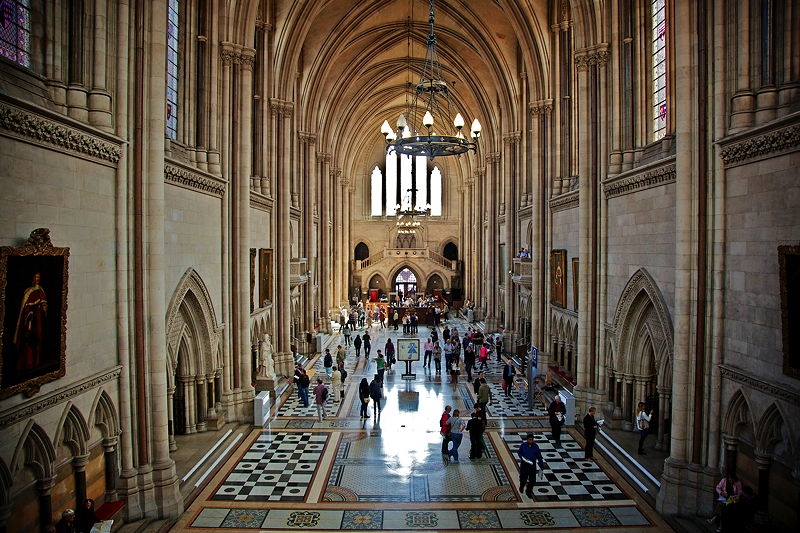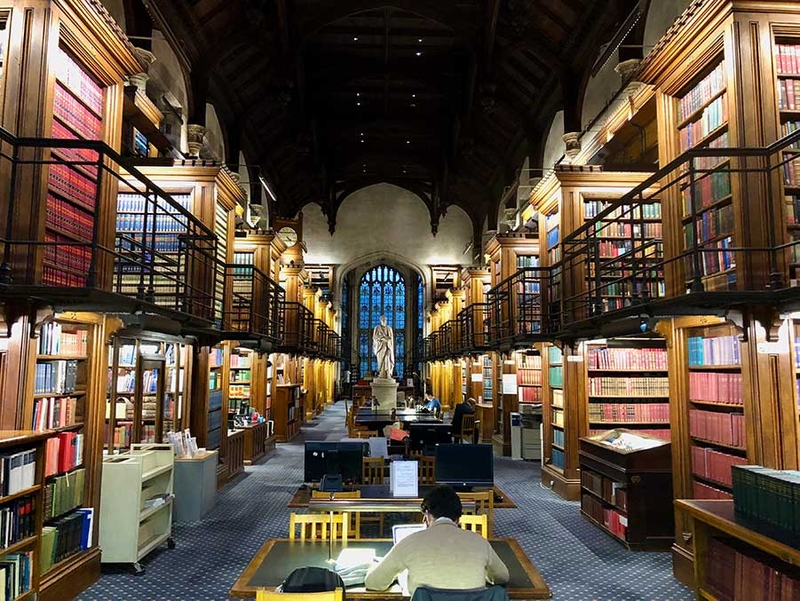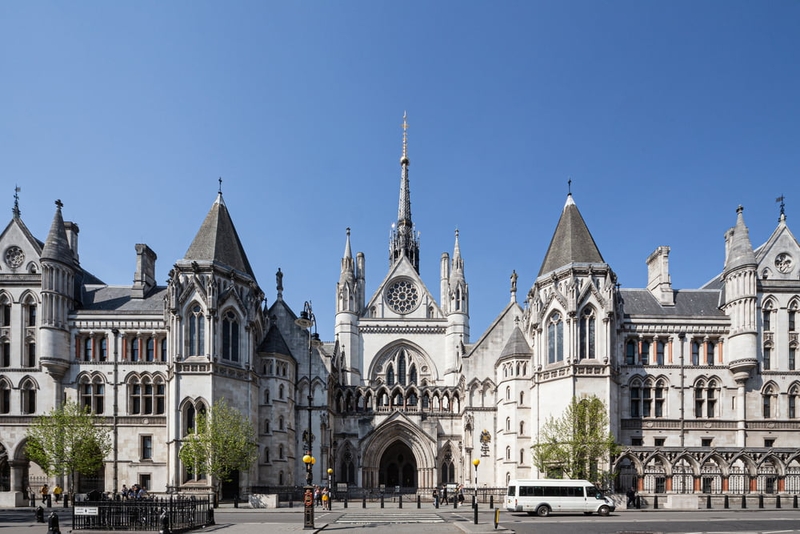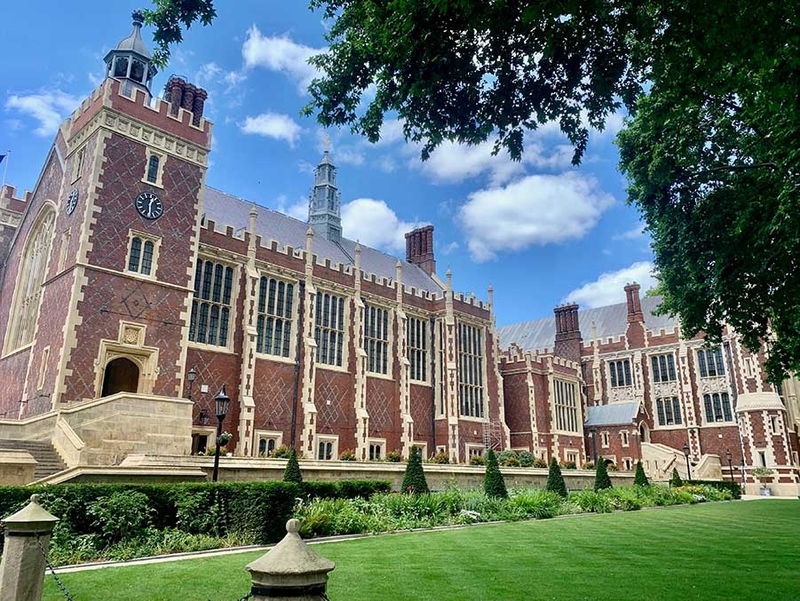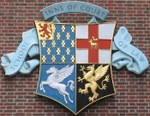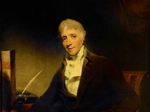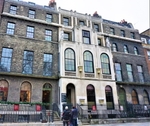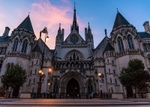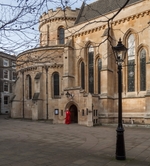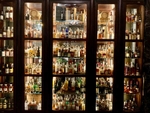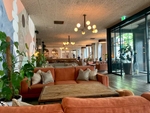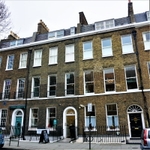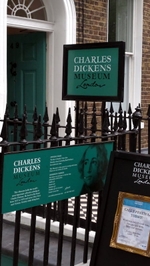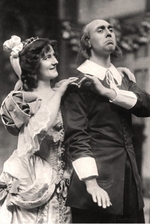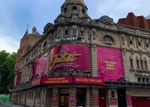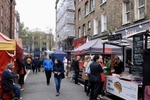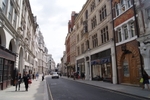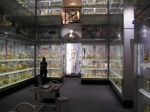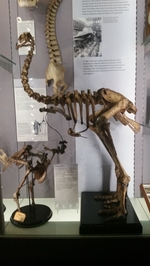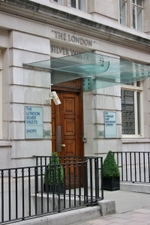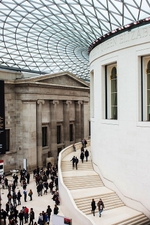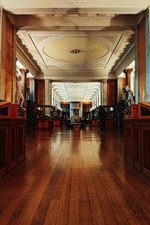1. Inns of Court
Lincoln’s Inn and Gray’s Inn are two of London’s historic Inns of Court. Today, the architecture, public squares and parks surrounding the inns can be admired by visitors.
Lincoln’s Inn
This historic centre for the continued education of barristers covers 11 acres of ground off Chancery Lane. There are several pedestrian entry points and visitors can walk around the precincts of the Inn.
Lincoln's Inn Chapel is a must-see. Designed by Inigo Jones and consecrated in 1623, Sir Christopher Wren later advised on renovations in 1685. The chapel is distinctive for being raised off the ground, with an undercroft providing space for burials of important barristers and judges. The Chapel is also unusual for having two aisles.
Interesting fact...
In Victorian times, babies were often abandoned on the steps of the Chapel so they could be cared for by barristers and their families. The infants were given the surname Lincoln!
The oldest surviving building in the precinct is the Old Hall which dates back to 1490. It has been used over the centuries by barristers (including Sir Thomas More) for eating, drinking and debating.
The pieces de resistance, however, are Lincoln's Inn's Grand Hall and Library. The Hall is cavernous and decorated with huge murals by George Frederick Watts and the coats of arms of barristers who have become High Court Judges. It was opened by Queen Victoria in 1845.
As for the library, it feels like you have walked into Hogwarts: it has beautiful wood-panelled, with statues of famous judges of yesteryear and that slightly musty smell of old paper. Wonderful!
While visitors are not able to access the buildings, you can still get a feel for the Inn and take in the striking architecture as you walk around the precinct. You'll probably also spot a barrister rushing off to court in his wig and gown.
Lincoln's Inn also offers group tours at £15 per person.
Lincoln’s Inn Fields
At five hectares, Lincoln's Inn Fields is the largest public square in London.
Laid out in 1603, and adjacent to Lincoln's Inn, the Fields offer large grass areas for exercise and sunbathing, three tennis courts, an excellent pizza restaurant (Fields Bar & Kitchen), and various statues and memorials. It is an ideal spot for a walk in a green space when you want to have a break from the city streets.
Lincoln's Inn Fields also boasts striking architecture and an interesting history:
- The gazebo in the centre of the Fields has a brass plaque in its centre which reads: "Near this spot was beheaded William Lord Russell a lover of constitutional liberty 21 July AD 1683"
- Sir John Soane, architect of the Bank of England and avid amateur collector, lived at Number 12-14. His former house is now the Soane Museum, with its eclectic mix of artefacts still laid out as they were during Soane's life.
- Ramsay MacDonald lived at Number 3 Lincoln's Inn Fields for 20 years, before becoming Britain's first Labour Prime Minister.
- William Murray, later the great judge Lord Mansfield, also lived on the Fields - at number 56.
- The Royal Canadian Air Force Overseas had its headquarters at No 20 Lincoln's Inn Fields from December 1941 to July 1946. One of the Fields' footpaths has been named Canada Walk, with a memorial and maple tree planted to commemorate the RCAF.
These days, inhabitants of the buildings surrounding the Fields include the London School of Economics (with the £145m Marshall Building opening its doors in January 2022), the Royal College of Surgeons, the leading barristers' chambers Essex Court Chambers, and the Queen's solicitors Farrer & Co.
Gray’s Inn
Gray’s Inn has a huge, privately owned garden which is open to the public during the working day. This is another oasis of green calm within the area, with an enticing mix of lawns, flower beds and trees. The garden has a lot of history too, and even the main entrance gate at Field Court dates back to 1723.
Gray's Inn was badly damaged during the blitz, and so its buildings don't quite have the same history and grandeur as those of Lincoln's Inn.
2. Sir John Soane’s Museum
Sir John Soane was a renowned architect who accumulated an impressive collection of objects gathered from across the world.
It is a truly eclectic mix of artefacts, ranging from the sublime to the full on quirky.
Soane’s collection included art, sculpture, furniture and antiques, as well as architectural models and drawings.
The collection covers many time periods as well as continents. Within the museum’s Picture Room you will find works by Hogarth, Canaletto and JMW Turner. Down in the basement is the Sepulchral chamber where you will find one of the museum’s most treasured pieces, the sarcophagus of the Egyptian Pharaoh, Seti I.
The museum is packed with over 30,000 fascinating objects, displayed across three buildings at Lincoln Inn Fields. Each interior space is arranged in a manner which is a work of art in itself, complementing the antiquities on show.
Interesting fact...
Sir John Soane hated his son, and embarked upon a campaign to disinherit him. This culminated in a private Act of Parliament passed in 1833, four years before Soane's death, which established a board of trustees to whom Soane's house and collections would pass when he died.
This extraordinary collection is free to visit. The museum opens Wednesday to Sunday from 10am to 5pm. There is a Highlights tour which will take you around the museum as well as through the private apartments. The museum has a shop where you can purchase all your souvenirs.
3. Royal Courts of Justice
A tour of the Royal Courts of Justice brings you in to the inner workings of the British legal system.
The stunning Gothic architecture is akin to walking through a cathedral at times, with its high arches and stained glass windows.
You will be taken around a maze of corridors as you explore this fascinating building, complete with over 100 courtrooms. Don't forget to check out the Lord Chief Justice's Court (Court Number 4) and the exhibition of legal costumes.
Opened in 1822, the Royal Courts contain the High Court and Courts of Appeal for England and Wales. Organised tours allow visitors the unique chance to walk these corridors and admire the incredible Victorian architecture while learning the history behind the courts.
Courts are open to the public, so you can pop in to a hearing to see what is going on. But keep quiet and no eating or drinking - you wouldn't want to find yourself in contempt of court!
Interesting fact...
You'll be entertained by the debate between Judges and Barristers and some of the quaint traditions that still remain: Barristers still wear horsehair wigs and gowns for some hearings, and refer to each other as "my learned friend"!
The tours are informative and entertaining, led by guides with expert knowledge. You can expect your tour to last just over an hour, and in some circumstances it may be possible to view a live court case, but this can not be guaranteed.
Tours are priced at £14 for adults and £12 for children aged 14 years and under. There are group tour options available, starting from £275 for groups of up to 12 people. The tours are operated from Monday to Friday and there is a cafe which serves food and drink from 9.30am to 3.30pm.
4. Temple Church
This historic church was built in the 12th century by the Knights Templars.
The Round Church was modelled on the Church of the Holy Sepulchre in Jerusalem, with the nave added in Norman times. In more modern times the church was a key setting for the book and film adaptation of The Da Vinci code.
Visitors are welcome to walk around this beautiful church containing so much history. The Magna Carta exhibition in the Round Church acknowledges the important role Temple Church played during the fraught negotiations which ended with the formation of this vital charter.
Life size effigies of Knights Templar greet you as you enter the church, the most famous of which is Sir William Marshall, a knight who served five kings through his lifetime. His is one of the many tombs you can see in the church.
Temple Church is one of the oldest buildings remaining in the capital. It is located within a quiet courtyard just to the south of Fleet Street. Admission to this church packed with history is from £3, with children admitted for free.
The church is usually open Monday to Friday between 10am and 4pm.
5. Food and Drink
Holborn and Chancery Lane is an area with an excellent variety of cuisines, plus a good number of old-style, traditional pubs. The following are a selection of the best places for food and drink.
Holborn Dining Room ££££
Located in the Rosewood Hotel in High Holborn, this brasserie offers seasonal British food with a modern twist. The mains on the a la carte menu start from £19.50, but the Holborn Dining Room has also built a reputation for its pies. Try the chicken, chestnut mushroom and tarragon pie priced at £23, or perhaps the vegetarian option, the Dauphinoise potato, Winterdale cheddar and caramelised onion pie for £22.
L'Oscar ££££
L'Oscar is a high-end French restaurant found a minute from Holborn tube. The decor is sumptuous, with an onyx bar, floor to ceiling mirrors, gilded panels and original artwork. Mains are priced in the £25-40 range, so it isn't cheap. But the food, atmosphere and service are top notch.
Scarfes Bar ££££
Also in the Rosewood, Scarfes Bar is a fantastic place for a refined drink. The decor is sumptuous and there is always a good atmosphere. Check out their fantastic whiskey collection!
One Aldwych ££££
Another venue for a classy drink is One Aldwych's Lobby Bar. This haunt has high ceilings, beautiful artwork, a peach tree as its centrepiece, and exquisite cocktails to boot. It ain't cheap (cocktails start at £16) ... but it will provide a memorable venue for a special occasion.
The Hoxton Holborn £££
The Hoxton Holborn is another trendy venue: with loads of comfy seating and a great vibe, come here for a leisurely morning coffee or an afternoon cocktail.
The Seven Stars ££
For those after something a little bit different, The Seven Stars is a great option. This small pub adjacent to the Royal Court of Justice has been around since the 1500s. These days the landlady is the fantastically named Roxy Beaujolais. Don't miss the interesting artefacts in the bars. Particularly good on a summer's day.
The Shell £££
A seafood restaurant which aims to show off all that is good in fresh, quality shellfish. The menu includes hot and cold seafood meals with sharing dishes also available. As an example, the lobster gratin mix platter for one costs £44.90, while the platter for two costs £76.90. As well as seafood there are meat dishes available including sirloin steak, plus a vegetarian burger on the main menu too. The Shell opened in 2020, but is getting a great reputation for high quality produce at reasonable prices.
The Lamb ££
This is one of the many traditional pubs you can enjoy around Holborn and Chancery Lane. Sat between Holborn and Russell Square station, seasonal British dishes can be accompanied by traditional cask ales. The Victorian décor spreads over both floors, while the beer garden is a hidden gem for alfresco dining. The all day menu contains your British pub classics, which are further adorned on Sundays by a choice of roasts from £18.
Cigalon £££
Cigalon is a contemporary French restaurant located in a former auction house on Chancery Lane. The seasonal menu shows off the best in authentic Provençal dishes. Set menus offer two courses for £30 and three courses for £35, or you may opt for the five course tasting menu priced at £42 per person. Downstairs from Cigalon is Baranis, a chic cocktail bar.
6. Charles Dickens Museum
No other author is as associated with London as Charles Dickens.
This museum located in Doughty Street is the house where Dickens lived between 1837 and 1839. Visitors have the chance to wander around the house where the acclaimed author wrote The Pickwick Papers, Oliver Twist and Nicholas Nickleby.
The museum allows you to step back in time as you visit the study, bedroom, dining room, servants bedroom and more while walking around the house. The furnishings, decorations and portraits you see belonged to Dickens, providing an authentic feel of how the great man lived.
The museum boasts over 100,000 pieces including letters, clothes and illustrations, as well as all the furnishings. Objects on display include the court suit Dickens wore to a reception hosted by the Prince of Wales, his will and the preliminary sketches for Nicholas Nickleby.
Admission to this historic house starts from £7.50. The museum opens Wednesday to Sunday from 10am to 5pm, with last entry at 4pm. Pop in to the museum’s Curiosity shop for your Dickens themed souvenirs.
7. Shaftesbury Theatre
Holborn borders London’s theatre land, with Shaftesbury Theatre a short walk from Holborn station.
It is the largest independent theatre in the West End and a great destination when you want to take in a show during your visit.
The theatre has three levels, consisting of the stalls, Royal circle and the Grand circle. From its opening back in 1911, Shaftesbury Theatre has staged many acclaimed productions, a tradition it continues today. Be sure to check out their what’s on page and book early to avoid disappointment.
The Shaftesbury Theatre is current showing & Juliet, a remixed version of the most famous love story of all time. The strap line says that the show proves that "There is love after Romeo", with the musical featuring songs like Baby One More Time and Since U Been Gone.
Evening performances start from 7.30pm from Monday to Saturday, with matinee performances on Friday and Saturday at 2.30pm. Prices vary according to seating position and can range between £22.50 to £99.50. Day tickets are sometimes available from the box office at noon on the day of the show, priced at £25.
There are tours of this lovely grade II building which provide an insight in to what goes on behind the scenes. The theatre supports local restaurants and sometimes has exclusive deals which can help save money on a pre-show meal.
8. Shopping
The streets around Holborn and Chancery Lane have a good mix of branded and independent stores.
Among the brands you will find here are New Look, Superdrug, Waterstones, Charles Tyrwhitt, Cotswold Outdoor, TM Lewin and Robert Dyas.
Holborn is home to a number of independent jewellers, including Holborn Vintage Jewellery which is nearing 100 years since the business was founded.
Leather Lane Market
This historic market spans the length of the lane, a place where you can pick up pretty much anything. Originally a market centred on leather goods and clothing, traditional stalls still sell homeware, arts and craft pieces, fruit and veg, flowers and more. In recent times the market has become renowned for the quality of its food stalls, with plenty of street food offerings.
The Old Curiosity Shop
As you are in Dickens territory, a shopping trip to Holborn should include a visit to the Old Curiosity Shop, tucked away on Portsmouth Street. We can debate whether this 500 year old shop actually inspired the Dickens novel or not, but the overhanging upper storey, uneven floors and wooden beams whisks you back to the time of Dickens. Today the shop sells high-end shoes.
9. Museum of Comedy
The Museum of Comedy plays host to the best upcoming comedians while also paying tribute to the great comedians of the past.
You can admire the museum’s collection of comedy artefacts before being entertained in the intimate 72 seat Comedy Crypt venue.
As well as being introduced to new comedians, you can also see established acts performing new routines ahead of major tours. Frankie Boyle and Stewart Lee are just two of the comedians who have performed progress shows in the Comedy Crypt.
The museum holds artefacts from favourite shows such as Spitting Image, Steptoe and Son and many more. Bill Bailey’s famed 6-neck guitar and Steve Ullathorne’s portraits of comedy stars are further highlights which you can peruse over a pre-show drink.
The museum can be found on Bloomsbury Way and is a six minute walk from Holborn tube station. The venue’s bar opens an hour prior to each performance, and while ticket prices vary, they can start from just £3 for the weekly Monday Club night.
10. Hunterian Museum
This is not your average museum and perhaps not one for the squeamish.
The Hunterian Museum has a vast and fascinating collection of anatomical specimens and surgical equipment. John Hunter was an eighteenth century surgeon whose collection was bought by the Scottish government in 1799.
Over the years the collection has been further added to and is held at the Royal College of Surgeons located off Lincoln Inn Fields. The museum covers 400 years of surgery, medicine and natural history with over 3,500 items, including many of Hunter’s original specimens.
The museum holds many events through the year including tours, talks and workshops to further your learning in anatomy and surgical methods though the years. This unique collection offers visitors the chance to view an unrivalled collection of human and non-human anatomical specimens, as well as surgical instruments, paintings and sculptures.
11. More things to do in Holborn and Chancery Lane
There are plenty of things to see and do in Holborn and Chancery Lane. Here are a few more places to visit when you are in the area.
British Museum
If you are visiting Holborn then a short trip across to the British Museum in neighbouring Bloomsbury is always worth the effort. Two million years of human history is spread across the museum galleries, including some of the most famous artefacts in the world.
The Rosetta Stone, the Portland Vase, the Sutton Hoo burial helmet and the Elgin Marbles are some of the many highlights of the British Museum. Open daily from 10am to 5pm, the museum is free to enter, although donations are welcome toward helping preserve these treasures of human history.
Silver Vaults
Holborn is renowned for its independent jewellers. The unique Silver Vaults located beneath Chancery Lane houses 29 specialist shops where you can buy both modern and antique silver items and jewellery.
These independent retailers provide expert knowledge to their customers. Open every day except Sunday, this is the largest selection of antique and modern silver anywhere in the world, and is just a five minute walk from Chancery Lane tube station.
All Star Lanes
All Star Lanes serves up a retro American bowling lane experience. The Holborn venue has four lanes set among a retro décor. The menu also has a nod to classic American comfort food, including the Top Dog frankfurter and the Lebowski brunch offering, with a 6oz chuck steak and rib cap patty.
All Star Lanes offers an all round good night out, with Karaoke bars and cocktails further features. A maximum of six people are permitted per bowling lane, with adult prices per game starting from £7.50 during off peak times.
